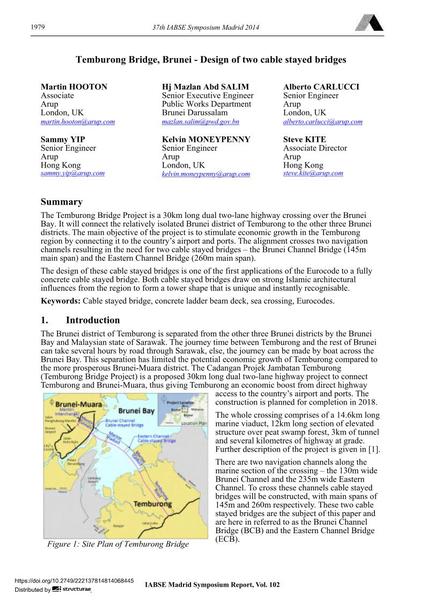Temburong Bridge, Brunei - Design of two cable stayed bridges

|
|
|||||||||||
Bibliographic Details
| Author(s): |
Martin Hooton
Hj Mazlan Abd Salim Alberto Carlucci Sammy Yip Kelvin Moneypenny Steve Kite |
||||
|---|---|---|---|---|---|
| Medium: | conference paper | ||||
| Language(s): | English | ||||
| Conference: | IABSE Symposium: Engineering for Progress, Nature and People, Madrid, Spain, 3-5 September 2014 | ||||
| Published in: | IABSE Symposium Madrid 2014 | ||||
|
|||||
| Page(s): | 1979-1986 | ||||
| Total no. of pages: | 8 | ||||
| Year: | 2014 | ||||
| DOI: | 10.2749/222137814814068445 | ||||
| Abstract: |
The Temburong Bridge Project is a 30km long dual two-lane highway crossing over the Brunei Bay. It will connect the relatively isolated Brunei district of Temburong to the other three Brunei districts. The main objective of the project is to stimulate economic growth in the Temburong region by connecting it to the country’s airport and ports. The alignment crosses two navigation channels resulting in the need for two cable stayed bridges – the Brunei Channel Bridge (145m main span) and the Eastern Channel Bridge (260m main span). The design of these cable stayed bridges is one of the first applications of the Eurocode to a fully concrete cable stayed bridge. Both cable stayed bridges draw on strong Islamic architectural influences from the region to form a tower shape that is unique and instantly recognisable. |
||||
| Keywords: |
concrete ladder beam deck sea crossing Eurocodes cable stayed bridge
|
||||

